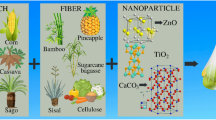Abstract
Biodegradable polymer from thermoplastic waxy rice starch (TPWRS) was prepared by internal mixer and compression molding. Since tensile properties and water uptake of the TPWRS was still the main disadvantages, the TPWRS sample was, therefore, modified by agar and/or cotton fibers. The effect of different ratios of agar:cotton fibers on properties of the TPWRS matrix were also studied. It was found that new hydrogen bonds could be found for the TPWRS matrix with the addition of different ratios of agar: cotton fibers by the detection of IR peak shift. Tensile properties of the TPWRS sample were significantly improved by the addition of agar or cotton fibers and the highest tensile properties were obtained from the TPWRS composite modified with 4:6 agar:cotton fibers. In addition, thermal degradation temperature and thermal stability of the starch were improved by the incorporation of agar and/or cotton fibers. Moreover, color measurement, morphology, water uptake and biodegradability from soil burial test were also examined.






Similar content being viewed by others
References
BeMiller JN, Whistler RL (2009) Starch: chemistry and technology. Academic Press, New York
Curvelo AAS, Carvalho AJF, Agnelli JAM (2001) Carbohydr Polym 45:183
Ma XF, Yu J, Kennedy JF (2005) Carbohydr Polym 62:19
Fishman ML, Coffin DR, Konstance RP, Onwulata CI (2000) Carbohydr Polym 41:317
Dai H, Chang PR, Geng F, Yu J, Ma X (2009) J Polym Environ 17:225
Corradini E, Imam SH, Agnelli JAM, Mattoso LHC (2009) J Polym Environ 17:1
Martins IMG, Magina SP, Oliveira L, Freire SR, Silvestre AJD, Neto CP, Gandini A (2009) Comp Sci & Tech 69:2163
Prachayawarakorn J, Sangnitidej P, Boonpasith P (2010) Carbohydr Polym 81:425
Prachayawarakorn J, Rattanabus P, Boonsom P (2011) J Polym Environ 19:274
Taguet A, Huneault MA, Favis BD (2009) Polymer 50:5733
Wang S, Yu J, Yu J (2006) J Polym Environ 14:65
Rosa RCR, Andrade CT (2004) J Appl Polym Sci 92:2706
Corradini E, Madeiras ES, Carvalho AJF, Curvelo AAS, Mattoso LHC (2006) J Appl Polym Sci 101:4133
Phillips GO, Williams PA (2000) Handbook of hydrocolloids. Woodhead Publishing, Cambridge
The DP, Debeaufort F, Voilley A, Luu D (2009) Food Hydro 23:691
Lyons JG, Geever LM, Nugent MJ, Kennedy JE, Higginbotham CL (2009) J Mech Behav Biomed Mater 2:145
Aoi K, Takasu A, Tsuchiya M, Okada M (1998) Macromol Chem 199:2805
Pawlak A, Mucha M (2003) Thermo Chemica Acta 396:153
Hatch KL (1993) Textile science. West Publishing, New York
Morton WE, Hearle JWS (1997) Physical properties of textile fibers. The Textile Institute, Manchester
Raphael E, Avellaneda CO, Manzolli B, Pawicka A (2010) Electrochim Acta 55:1455
Acknowledgements
The authors express their sincere appreciation to the Commission on Higher Education and Thailand Research Fund for supporting the study financially.
Author information
Authors and Affiliations
Corresponding author
Rights and permissions
About this article
Cite this article
Prachayawarakorn, J., Limsiriwong, N., Kongjindamunee, R. et al. Effect of Agar and Cotton Fiber on Properties of Thermoplastic Waxy Rice Starch Composites. J Polym Environ 20, 88–95 (2012). https://doi.org/10.1007/s10924-011-0371-8
Published:
Issue Date:
DOI: https://doi.org/10.1007/s10924-011-0371-8




